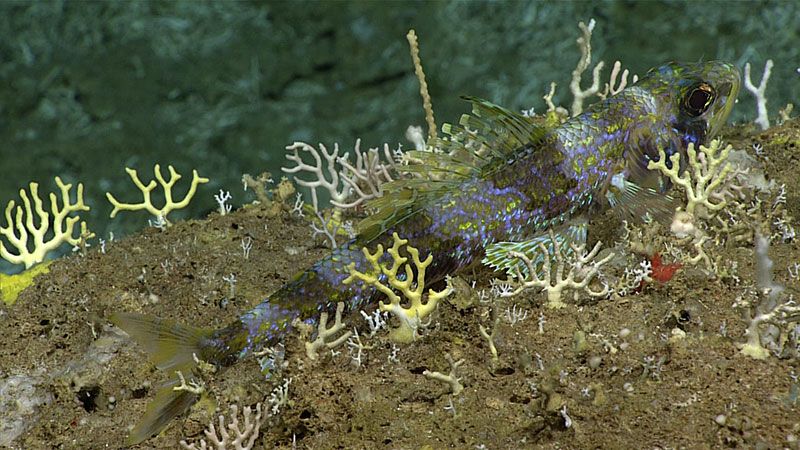Successful Multiyear Effort to Study Deep-Sea Corals and Sponges in the Southeast United States
January 26, 2022
NOAA’s Deep Sea Coral Research and Technology Program has completed its multiyear highly collaborative effort known as the Southeast Deep Coral Initiative. Initiative collaborators explored and characterized deep-sea coral and sponge ecosystems in the federal waters of the U.S. South Atlantic, Gulf of Mexico, and Caribbean. Researchers completed 21 expeditions to survey deep-sea coral and sponge ecosystems using ships, submersibles (including remotely and autonomously operated vehicles), and other equipment. Complementary research projects conducted in partnership with universities focused on seafloor mapping, species identification, habitat suitability modelling, environmental and oceanographic monitoring, and data analysis.

This yellowfin flagfish was photographed between a colony of lace corals during a 2018 expedition to collect information on unknown and poorly understood deepwater areas surrounding Puerto Rico and the U.S. Virgin Islands. Image courtesy of NOAA Ocean Exploration, Océano Profundo 2018. Download largest version (1.3 MB).
The Southeast Deep Coral Initiative, which began in 2016, was led by NOAA’s National Centers for Coastal Ocean Science in collaboration with NOAA Fisheries, NOAA Ocean Exploration, and the Office of National Marine Sanctuaries. This effort was made possible through a variety of funding sources and extensive local, academic, and federal partners. NOAA has published the final initiative report.
The full story is available on the NOAA Fisheries website.
NOAA Ocean Exploration-supported expeditions related to the Southeast Deep Coral Initiative:- Southeast Deep Coral Initiative: Exploring Deep-Sea Coral Ecosystems off the Southeast U.S.
- Gulf of Mexico 2017
- Gulf of Mexico 2018
- Windows to the Deep 2018: Exploration of the Southeast U.S. Continental Margin
- Océano Profundo 2018: Exploring Deep-sea Habitats off Puerto Rico and the U.S. Virgin Islands
- Deep Sea Exploration and Research of Coral/Canyon/Cold seep Habitats (DEEP SEARCH)
- Windows to the Deep 2019: Exploration of the Deep-sea Habitats of the Southeast United States
- 2019 Southeastern U.S. Deep-sea Exploration – Remotely Operated Vehicle and Mapping Operations
Published January 26, 2022